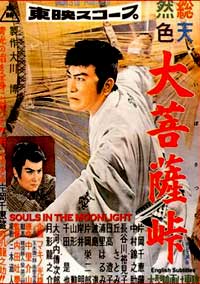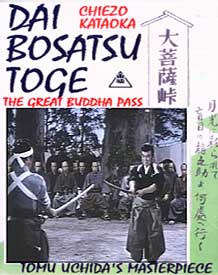 Cheizo Kataoka before beginning filming on Souls in the Moonlight Part I (Daibosatsu toge dai ichibu, 1957) created the "silent" sword stance affected by the character of Ryunosuke, & if he's not exaggerating, Raizo Ichikawa emulated the stance fairly closely in his remade Satan's Sword trilogy.
Cheizo Kataoka before beginning filming on Souls in the Moonlight Part I (Daibosatsu toge dai ichibu, 1957) created the "silent" sword stance affected by the character of Ryunosuke, & if he's not exaggerating, Raizo Ichikawa emulated the stance fairly closely in his remade Satan's Sword trilogy.
It is not a stand-out form, however, as the "style" is essentially standing very still with sword held forth & slightly to the left, & gazing intensely at the unnerved opponent.
Chiezo was of the opinion that this alone was revolutionary because swordfight samurai films were called chambara because they were raucous, busy, stagy, rapid movements to drumming & cymble accompaniment said to sound like chan-chan bara-bara.
In that context, to stand silently & stair was novel. However, the "tableau" of motionless stance had been around a long while before 1959, including even in silent films starring himself when he was a whole lot younger. So Chiezo does seem to be exaggerating a bit.
And even in the context of the films, his opponents likewise stand rigid & silent assessing the opponent's stance. It took Tatsuya Nakadai in Sword of Doom (Daibosatsu toge, 1966) to really devise a form that was deceptive & thereby potentially evil. The "silent form" was said to be sinister, & since the sword reflected the soul, to adapt an evil sword style was to become an evil man.
Nakadai's performance in the role was thus the best. He takes a stance leaning to one side, as though his footing were unbalanced, his sword pointing toward the floor & to one side as though unready, & he looks the wrong direction as though inattentive of the duel. It traps an opponent because really this stance is very alert & ready while seeming not to be.
Cheizo however created not one but two styles for the role. Raizo Ichikawa imitated only the first in the Satan's Sword trilogy. After Ryunosuke was blinded when the Tenchu group was bombed into extinction, he changes his style to one that clearly relies on hearing & appears more defensive until it erupts into assault.
So Chiezo had created a "blind style" which was convincing & very interesting, long before the advent of Zatoichi.
The only drawback is that the blind style is somewhat at odds with the original story's contention that Ryunosuke created a deceptive style that continued to be effective even after he was blinded. Raizo Ichikawa in Satan's Sword was probably correct in keeping to that deceptive style even after Ryunosuke became blind.
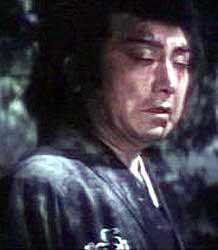 Tatsuya Nakadai didn't have to make such a choice, since Sword of Doom does not penetrate the story to the point of Ryunosuke's blindness. Tatsuya Nakadai didn't have to make such a choice, since Sword of Doom does not penetrate the story to the point of Ryunosuke's blindness.
It could be noted that Chiezo did not consider himself a martial artist per se. He adapted an artificial kabuki style, tightening what was extravagant on a big stage so that it would fit within the confines of the camera's frame.
He had a profound understanding of the visual impact of postures & movement. Some critics who'd themselves studied use of the katana have criticized Chiezo as less than an authentic swordsman, & delighted in his confession not to be one.
But I think they miss the point. The various chambara styles of swordplay rarely represent authentic swordstyles which would not be as easily captured as a filmic image, & Chiezo perfectly understood the difference.
He had been creating just such cinematic images of swordsmanship even in the silent era, & was a major influence defining the look of the genre, & even in this postwar era he remained influential in the art of looking cool on the screen. In the late 1920s he founded his own film studio so that he could pursue both psychological & swordplay realism above & beyond what established studios were up for.
So despite that Nakadai out-did him in this particular role for amazing stances, Chiezo's were advanced for that decade, & other of his roles, like the cherry-tattooed judge, have amazing stances that can still wring gasps of awe from the viewer just by going down on one knee.
Tatsuya Nakadai as Ryunosuke in Sword of Doom appears to be truly psychotic, but Chiezo in Souls in the Moonlight seems never fully to have understood the character. Or, he perfectly understood him but could not bare to portray a truly psychopathic anti-hero.
Nakadai with his Shakespearean training well understood the anti-hero through Hamlet or McBeth, but Chiezo came out of the kabuki theater tradition wherein good was good & evil was evil & an evil hero was unthinkable.
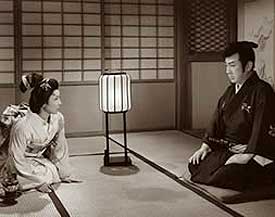 And much as I adore Chiezo as an actor & enjoyed him even here, he was frankly old for the role. He does not seem like the "young master" as Ryunosuke is called, but more the "middle aged master." And much as I adore Chiezo as an actor & enjoyed him even here, he was frankly old for the role. He does not seem like the "young master" as Ryunosuke is called, but more the "middle aged master."
The character type is called nihirisuto (an English borrowing adapted from nihilist). The nihirisuto breaks taboos without concern for repurcussions, has antisocial tendencies, takes risks dangerous even to himself as though it doesn't matter if he lives or dies, though much better if everyone else dies first.
Tales of nihirisuto anti-heros are mostly set in the chaotic times at the end of the Edo Period, called the Bakumatsu Era, though occasionally (as with Musashi Miyamoto who is of the type) they are placed at the start of the Tokugawa era as lost souls unable to cope with the break-out of peace.
Such men of Bakumatsu existed in fact. Consider Hijikata of the Shinsen Group, a homosexual psychopath who in the name of protecting the failing Shogunate was capable of killing even fellow members of Shinsengumi with ease & delight.
It's no coincidence that fictional Ryunosuke Tsukue enters into Kondo, Serizawa & Hijikata's sphere during the tale, as they are two of a kind, all right out of history. Purportedly even the character of Ryunosuke Tsukue was based on an actual swordsman of the Kogen-itto-ryu school, whose name was Fuda Ryuzaburo Takafumi, but as recreated for novels, stage, & film he has to be regarded as thoroughly fictional.
Eventually the nihirisuto anti-hero would become the type of yakuza gangster at the opposite end of the ninkyo or chivalrous yakuza. The nihirisuto yakuza exemplified by many roles played by Bunta Sugawara's acted out of viciousness rather than from any code of honor or chivalrous motivation. The very title of Bunta's Battles Without Honor & Humanity (Jingi naki tatakai, 1973) says it all.
As a cinematic entity such ignoble inhumane heros originated as dark-souled samurai mostly of the Bakumatsu era, usually but not exclusively ronin, exemplified by Ryunosuke Tsukue of Daibosatsu toge. As directed by Okamoto with Tatsuya Nakadai in the title role, this was not just a nihirisuto-mono or nihilist story, but additionally it was zongoku jidai-geki or cruel history-tale.
What the original author of the novel saw as a man struggling within his karma Okamoto saw as mentally ill. The noirish black & white cinematography & Nakadai's glazed look of insanity exagerates Ryunuke's madness as his primary motivation.
The same character as played by Raizo Ichikawa in a color trilogy is much more the conflicted madman. And as played by Chiezo Kataoka in Tomu Uchida's earlier color trilogy, there are moments when he actually seems to be kind of a nice guy who made some savage mistakes.
Insofar as the originating author made Ryunosuke's actions the result of a karmic condition rather than a disease, both Raizo Ichikawa's & Chiezo Kataoka's take on the character would be closer to the original.
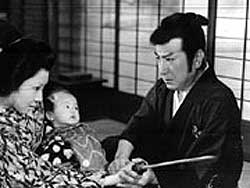 When Chiezo as Ryunosuke first appears in Daibosatsu toge's first installment, he is telling a harmless old man to look the other direction, then slices him down the back, perhaps only to test his sword. This pointless murder of a harmless person will ruin many lives, indirectly even his own, but he walks away without concern.
When Chiezo as Ryunosuke first appears in Daibosatsu toge's first installment, he is telling a harmless old man to look the other direction, then slices him down the back, perhaps only to test his sword. This pointless murder of a harmless person will ruin many lives, indirectly even his own, but he walks away without concern.
This opening to the saga was so famous from the book that it dared not be weakened. It was an outright act of cruelty without just cause of any kind. Yet thereafter Chiezo backs away from the character, striving to enhance Ryonosuke as a heroic figure.
The pointless murder was supposed to be followed up with an equally heartless act of rape, which takes place inside a symbolically pounding millworks, as adhered to in versions starring Tatsuya Nakadai & Raizo Ichikawa.
In this version, however, the millworks is silent & disused, reversing the symbology, & Ryonosuke does not rape Ohama the wife of Utsuki Bunnojo, whose husband he is slated to duel.
The fact that they were alone in the mill ruins her reputation, gets her divorced by an unreasonable husband, & sets her life on the down-slide with Ryunosuke. This means that it is her husband's mistrust, not Ryunosuke's cruelty, that set further tragedies in motion. It completely undermines the sense of Ryonosuke as possessing a quality of cruelty if not madness.
Thus when he kills an opponent during a contest with wooden swords & ends up fleeing his home town, very little of it is his fault, certainly not entirely his fault. He's portrayed more as the heroic victim caught in a downward spiral of fate, rather than as the pure nihilist afflicted by karma as in the original story.
It's Chiezo's interpretation but I can't help but feel his ego got in the way, his unwillingness to become a truly hateful monster in a film. In other respects the film follows the familiar story fairly closely, & Chiezo does a good job as long as one can accept that a middle-aged man is suited to a role of a wild young ronin.
By his obvious age he should already long ago have had his personality & his future decided, yet he sets out on the gloomy trail of adventures like some kid on a mission of knight errantry gone awry. Raizo Ichikawa & Tatsuya Nakadai both look much, much more the part of the young samurai who, struggling to find himself, finds only darkness.
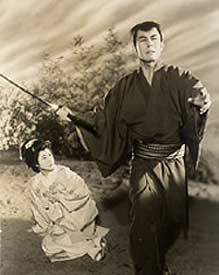 Omatsu whose grandfather was murdered at Great Bodhisattva Pass stays a while with a concerned older fellow who she does not realize is a professional thief.
Omatsu whose grandfather was murdered at Great Bodhisattva Pass stays a while with a concerned older fellow who she does not realize is a professional thief.
As his illicit work takes him away from the village for weeks or months at a time, he cannot adopt her. So he takes her to Edo hoping she can enter the household of her aunt, who alas rejects her.
Her story is told in considerable detail. Shichibei the thief can hardly believe the depth of wickedness of the aunt's pretence that she had no such relative. Omatsu is taken in by a flower-arrangement teacher who has no family of her own, so is for a while safe from the world's vagueries that will eventually overtake her.
But Shichibei is not satisfied. He noted that the aunty, married to a wealthy merchant, was having an affair with the store manager. Using his thief's skills, he breaks into the store by night, fights the couple making love, ties them together, & drags them into the streets to be discovered the next morning.
The adulterers are cast out of the merchant's household to live precariously thereafter. They will eventually cause considerable grief to innocent Omatsu either from revenge against her protector Shichibei or from pure malice.
Ohama whom Ryunosuke widowed follows him & they become lovers. Since she was never raped by him in this version, her affection for him is less perverse, & her eventual emotional breakdown & attempt to kill him is less significant as well.
Chiezo's refusal to play the character at the full edge of his karmic wickedness has a domino effect for the motives of other characters, making this if not a weaker film, a spiritually very different one at least.
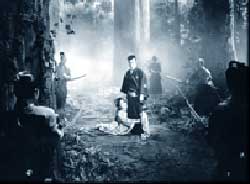 The excessive youthfulness of babyfaced Kinnosuke Nakamura as the family avenger Hyoma has the effect of underscoring Chiezo being miscast for age. Ryunosuke has never before met Hyoma when he comes to the dojo of the great swordsman Shimada (Isao Yamagata) to challenge the famous sensei. He is passed on to his leading student, Hyoma, who likewise does not know Ryunosuke by sight, & who has been living under an assumed name. The excessive youthfulness of babyfaced Kinnosuke Nakamura as the family avenger Hyoma has the effect of underscoring Chiezo being miscast for age. Ryunosuke has never before met Hyoma when he comes to the dojo of the great swordsman Shimada (Isao Yamagata) to challenge the famous sensei. He is passed on to his leading student, Hyoma, who likewise does not know Ryunosuke by sight, & who has been living under an assumed name.
Ryunosuke is about to repeat his deceptive style which would result in Hyoma's death by a crack to the head. Shimoda sticks his own bokken into the fray, stopping Ryunosuke's blow. Shimoda afterward refuses to duel the ronin, disregarding him so wholly that Ryunosuke leaves feeling belittled. Shimoda informs Hyoma that he should not fight Ryunosuke, as he would be killed, but should meditate upon how to cope with what he has seen.
Shimoda has a very important scene later in the film. In Kihachi Okamoto's version he is played by Toshiro Mifune who so owns the duel with members of Shinsen-gumi that the excellently staged versions in other versions pale. When Isao Yamagata as Shimoda defeats the best swordsmen of Shinsen-gumi, it's wonderfully done, but very hard not to remember Mifune's unrivaled "presence" when reenacting the same scene.
Shinsengumi men attacked him on the snowy lane as a matter of mistaken identity. He becomes angry with them for having forced him to waste precious lives. Throughout this amazing action sequence, Ryunosuke stood back in awe of the first swordsman he has ever seen whom he knows he cannot defeat.
Shimoda gives him a moment of spiritual advice that causes Ryunosuke thereafter to regard Shimoda as his sensei, though never again entering his dojo or in any way acknowledged as a pupil.
This is a very telling moment in Ryunosuke's personality, as he seems to be the ultimate alpha male who having no one above him, becomes the equivalent of a totalitarian tyrant with no concern for anyone beneath him. But when he feels himself knocked down a peg, & there is someone he can look up to in admiration, he is able for a while to find & express a greater humanity in himself.
Ryunosuke's association with Shinsengumi was always unofficial. Had he joined officially, he could leave only under penalty of death. He's not a man of political convictions, he's just a swordsman with a yen for slaughter. So one day he is fighting for the shogunate alongside Shinsengumi samurai, & soon after he fights alongside Tenchu men in support of the emperor.
During the Tenchu group's suppression, Ryunosuke lost his eyesight in an explosion that killed all remaining Tenchu men. Miraculously blindness has no negative impact on his fighting skill.
As Part I of Chiezo's Souls in the Moonlight trilogy ends, blind Ryunosuke in the midst of a duel slips from a high cliff, falling to what for anyone else would be his sure death. Talk about cliffhanger.
copyright © by Paghat the Ratgirl
|

